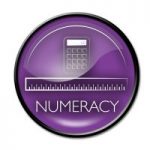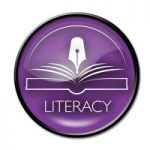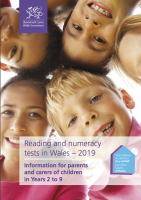KS3 Literacy & Numeracy
Why do we have national tests in Wales?
NRT stands for National Reading Test. The national tests have been developed specifically for use in Wales and are in line with what children are being taught in our schools. Schools have always used a variety of tests to check how well children are doing. With the national tests, which are based on the curriculum in Wales, teachers have consistent, detailed information on each individual learner’s development and progress in reading and numeracy (reasoning). The tests can also show where individual children may need more help to improve their skills. Beginning in the 2018/19 academic year, online personalised assessments are being phased in over a three-year period. This started with numeracy (procedural), which became available to schools in December 2018. Over time the online assessments are replacing the current paper-based national tests.
The tests can provide useful information to add to what your child’s teacher knows about their reading and numeracy (reasoning) from their work every day in the classroom. Teachers can use the results to identify strengths and also areas where more help may be needed. They may share this information with you at parent meetings. However, any test can only look at a limited range of skills and abilities. For example, the reading tests cannot provide any information on speaking, listening or writing skills. Some children will not perform at their best on the day of the test. As a result, their test results alone may not give a full picture of their ability. Each test is designed to measure achievement across the range expected for each year group. The tests will not always give reliable information for children who are working at the extremes, or out of the range for their age. It is important to discuss your child’s progress with their teacher based on all the evidence they have, rather than just focusing on a single test result. It is also important to remember that children do not all make progress at the same rate.
By the end of the summer term, your child’s school will give you test results for each test that your child has taken. The results should be read alongside your child’s annual report. The tests provide two kinds of result, an age-standardised score and a progress measure. These two results are very different from results you may have come across in other situations (e.g. 9 out of 10 or 90 per cent).
What is an age-standardised score?
Having a score of say ‘6 out of 10’ does not take into account how hard a test is or show how one child has done compared with other children taking the test. If most of the others taking the test scored 9 out of 10, then 6 is not a good score. But if the average score was 2 out of 10, then 6 is a very good score. The age-standardised score from the national tests tells you how well your child has done compared with other children of the same age (in years and months) taking the test at the same time. The average age-standardised score is set to 100 and about two-thirds of all children taking the test will have age-standardised scores between 85 and 115. So, an age-standardised score lower than 85 might suggest that a child is experiencing some difficulty with the reading or numeracy (reasoning) skills tested. Similarly a score greater than 115 might suggest that the child’s reading or numeracy (reasoning) skills are well developed for their age.
In a few cases, the range of difficulty of the questions in the test may mean that it is not possible to register an age-standardised score for a child whose reading and numeracy (reasoning) skills are developing more slowly than would be expected. The score could only be given as ‘less than 70’. If this is the case, your child’s teacher will use other methods to assess how their skills are developing. One of the things a teacher might do is to let your child try the questions from a test for the year group below to see if this helps to get a better picture of where they may need more help to make progress.
Similarly, very high achievers can only be given an age-standardised score of ‘more than 140’ because the test cannot assess the limit of their skills. Again, teachers will be able to give you more information about your child’s ability.
What is a progress measure?
The progress measure for the test shows how well your child has done compared to every other learner taking the test in their year group across Wales. Providing results in this way shows whether or not your child is maintaining their position in the year group over time and helps identify trends in their performance. Results for each year are presented in vertical blocks. Your child’s performance is marked as a ‘+’ within one of these blocks. The text provided under each result tells you if your child’s position in the year group is broadly consistent with, higher than, or lower than last year. This is based on annual test information and the change in your child’s progress measure from year to year. Progress measures that are broadly similar from year to year would suggest that your child is making steady progress within their year group. Small variations from year to year are expected. By using information from previous tests it is possible to work out an expected range for your child. Anything outside this range shows that the difference is likely to be due to a change in performance. If your child’s performance is higher or lower than last year, it may suggest that your child would benefit from more support or challenge. Your child’s teacher will be able to talk to you in more detail about the ways in which they are making progress in all aspects of reading or numeracy (not just on the tests) and what can be done to help to improve their skills.
Supporting your child’s learning
Getting involved in your child’s learning while at home and out and about can make a big difference to their progress. Any of the following will be a huge help.
- Reading and talking about any kind of text such as books, magazines, web pages, leaflets, notices.
- Using numbers when shopping, planning trips, looking at football scores, times of TV programmes.
- Sharing activities that involve reading and numeracy, such as cooking, playing board games, watching or playing sport, writing e-mails.
- Talking about words and numbers you come across in everyday life.
You can find more advice and guidance on supporting your child in reading and numeracy by visiting the following websites:
- Education begins at home. The things you do at home will help your child do so much better at school. For some great ideas visit: Education Wales – information about Education in Wales. www.facebook.com/educationwales/
- BookTrust – find a range of programmes and projects designed to help people of all ages and backgrounds enjoy reading and writing. www.booktrust.org.uk
- National Numeracy – help your child with numeracy. www.nationalnumeracy.org.uk/ your-childs-maths (This website is only available in English.)
- Bitesize – the BBC’s free online resource to help children in the UK with their school work. www.bbc.co.uk/bitesize
- MEIC – a confidential helpline service for children and young people in Wales. It offers help on a range of issues from finding out what’s going on in your local area to helping to deal with bullying. www.meiccymru.org
- Summer reading challenge – help with reading through the summer holidays. www.summerreadingchallenge.org.uk
- Hwb – the learning platform, full of useful resources. www.hwb.gov.wales


